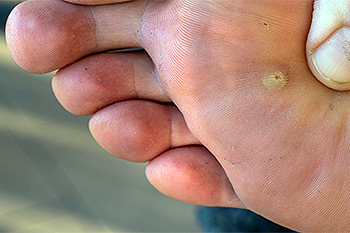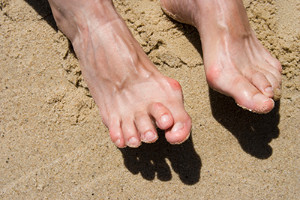Kirksville (660) 665-9000
August 2022
Discoloration and Toenail Fungus

Sometimes, a toenail’s natural translucent color can be manipulated into an entirely different shade. One potential common cause of such discoloration is toenail fungus. Toenail fungus can be caused by an organism named dermatophyte. If your toenail has been infected by a fungus, you might notice that the shade of the nail has changed to yellow, reddish brown, black, or green. This discoloration can start small, for example underneath the tip of the affected nail, before growing larger in size if unaddressed. There are also several things that can increase one’s risk of developing a toenail fungus. If you sweat frequently, walk barefoot in warm and moist environments, or are prone to enduring small cuts near the nail, you may be at an increased risk of developing toenail fungus and potentially discoloration. Of course, discoloration can be caused by things other than toenail fungus. Namely, injuries, nail polish, and particular health conditions can also contribute to discoloration. However, it is important for you to be aware of the causal connection between toenail fungus and discoloration of the toenail. If you have discoloration of the nail, contact a podiatrist.
If left untreated, toenail fungus may spread to other toenails, skin, or even fingernails. If you suspect you have toenail fungus it is important to seek treatment right away. For more information about treatment, contact Deborah Holte, DPM of Northeast Missouri Foot Clinic. Our doctor can provide the care you need to keep you pain-free and on your feet.
Symptoms
- Warped or oddly shaped nails
- Yellowish nails
- Loose/separated nail
- Buildup of bits and pieces of nail fragments under the nail
- Brittle, broken, thickened nail
Treatment
If self-care strategies and over-the-counter medications does not help your fungus, your podiatrist may give you a prescription drug instead. Even if you find relief from your toenail fungus symptoms, you may experience a repeat infection in the future.
Prevention
In order to prevent getting toenail fungus in the future, you should always make sure to wash your feet with soap and water. After washing, it is important to dry your feet thoroughly especially in between the toes. When trimming your toenails, be sure to trim straight across instead of in a rounded shape. It is crucial not to cover up discolored nails with nail polish because that will prevent your nail from being able to “breathe”.
In some cases, surgical procedure may be needed to remove the toenail fungus. Consult with your podiatrist about the best treatment options for your case of toenail fungus.
If you have any questions, please feel free to contact our office located in Kirksville, MO . We offer the newest diagnostic and treatment technologies for all your foot care needs.
Breaking Your Foot Is No Laughing Matter

Though it can be funny to think of breaking your foot as a valid excuse to get out of going to an event you would rather skip, to actually break your foot is not funny at all. You can sustain a foot fracture from falling, moving quickly (such as in running or another sport), twisting your foot to one side, dropping something heavy on your foot, or enduring other injuries. When a fracture first happens, it is important to take weight off of the affected foot and elevate it. If you see a bone sticking out of your foot, your foot looks deformed in some other way, your foot is numb or cold, or you are in severe pain, make an appointment with a podiatrist as soon as possible. Your broken foot will usually be cast and/or put into a walking boot until it heals. Surgery may be required. A broken foot is something to take seriously. A podiatrist can ascertain the severity of the break and provide the best treatment option for you.
A broken foot requires immediate medical attention and treatment. If you need your feet checked, contact Deborah Holte, DPM from Northeast Missouri Foot Clinic. Our doctor can provide the care you need to keep you pain-free and on your feet.
Broken Foot Causes, Symptoms, and Treatment
A broken foot is caused by one of the bones in the foot typically breaking when bended, crushed, or stretched beyond its natural capabilities. Usually the location of the fracture indicates how the break occurred, whether it was through an object, fall, or any other type of injury.
Common Symptoms of Broken Feet:
- Bruising
- Pain
- Redness
- Swelling
- Blue in color
- Numbness
- Cold
- Misshapen
- Cuts
- Deformities
Those that suspect they have a broken foot shoot seek urgent medical attention where a medical professional could diagnose the severity.
Treatment for broken bones varies depending on the cause, severity and location. Some will require the use of splints, casts or crutches while others could even involve surgery to repair the broken bones. Personal care includes the use of ice and keeping the foot stabilized and elevated.
If you have any questions please feel free to contact our office located in Kirksville, MO . We offer the newest diagnostic and treatment technologies for all your foot and ankle needs.
HPV and Plantar Warts

The medical name for a plantar wart is called verruca. This type of wart is located on the bottom of the foot, and it grows inward as a result of standing and walking for most of the day. It can cause severe pain and discomfort, and it may be difficult to complete daily activities. It can develop from contracting the human papillomavirus (HPV), and it is often contagious. The virus can enter the body through small cuts in the skin on the feet, and it is found in places that can include public swimming pools. Additionally, this virus can live on shower room floors and may also be found in locker rooms. These environments are warm and moist and are the perfect area for HPV to live. The wart appears as a small, thick area of skin on the heel or on the bottom of the toes, and it may have tiny black dots in the center. There are several methods of relieving the pain from a plantar wart, and it is advised that you confer with a podiatrist who can discuss proper treatment techniques with you.
Plantar warts can be very uncomfortable. If you need your feet checked, contact Deborah Holte, DPM from Northeast Missouri Foot Clinic. Our doctor will assist you with all of your foot and ankle needs.
About Plantar Warts
Plantar warts are the result of HPV, or human papillomavirus, getting into open wounds on the feet. They are mostly found on the heels or balls of the feet.
While plantar warts are generally harmless, those experiencing excessive pain or those suffering from diabetes or a compromised immune system require immediate medical care. Plantar warts are easily diagnosed, usually through scraping off a bit of rough skin or by getting a biopsy.
Symptoms
- Lesions on the bottom of your feet, usually rough and grainy
- Hard or thick callused spots
- Wart seeds, which are small clotted blood vessels that look like little black spots
- Pain, discomfort, or tenderness of your feet when walking or standing
Treatment
- Freezing
- Electric tool removal
- Laser Treatment
- Topical Creams (prescription only)
- Over-the-counter medications
To help prevent developing plantar warts, avoid walking barefoot over abrasive surfaces that can cause cuts or wounds for HPV to get into. Avoiding direct contact with other warts, as well as not picking or rubbing existing warts, can help prevent the further spread of plantar warts. However, if you think you have developed plantar warts, speak to your podiatrist. He or she can diagnose the warts on your feet and recommend the appropriate treatment options.
If you have any questions please feel free to contact our office located in Kirksville, MO . We offer the newest diagnostic and treatment technologies for all your foot and ankle needs.
Dealing With a Hammertoe

A hammertoe is when a toe is stuck in an upward bent position at the middle of a joint. The top of the toe is bent forward and looks like a hammer, hence its name. It is one of the most common deformities of the forefoot and can affect balance as well as cause pain and trouble with walking and other activities. Hammertoes can happen when the small muscles on the bottom of the feet (intrinsic muscles) are weaker than the larger muscles on the top of the foot (extrinsic muscles). Hammertoe can often be a result of other issues, such as having flat feet with longer metatarsals or middle foot bones, having a bunion, having a medical condition such as diabetes or inflammatory arthropathies that affect muscles, tendons, and nerves in the feet, and wearing shoes that are too narrow or tight, forcing the toes down into the tip of the shoe. Beyond pain, if you have a hammertoe, you may experience swelling or redness of the toe, callus formation on the parts of the toe that rub against the shoe, and changes in walking patterns. Treatment includes wearing properly fitted shoes with wide toe boxes, doing toe stretching and other exercises to build up the strength of the intrinsic muscles of the foot, wearing cushions, pads, or insoles, taping, and possibly surgery. Early intervention is more likely to work since the toe joint will be more apt to be flexible. If you feel you have a hammertoe, and particularly if it is causing you discomfort, talk with a podiatrist about treatment that might work best for you.
Hammertoes can be a painful condition to live with. For more information, contact Deborah Holte, DPM of Northeast Missouri Foot Clinic. Our doctor will answer any of your foot- and ankle-related questions.
Hammertoe
Hammertoe is a foot deformity that occurs due to an imbalance in the muscles, tendons, or ligaments that normally hold the toe straight. It can be caused by the type of shoes you wear, your foot structure, trauma, and certain disease processes.
Symptoms
- Painful and/or difficult toe movement
- Swelling
- Joint stiffness
- Calluses/Corns
- Physical deformity
Risk Factors
- Age – The risk of hammertoe increases with age
- Sex – Women are more likely to have hammertoe compared to men
- Toe Length – You are more likely to develop hammertoe if your second toe is longer than your big toe
- Certain Diseases – Arthritis and diabetes may make you more likely to develop hammertoe
Treatment
If you have hammertoe, you should change into a more comfortable shoe that provides enough room for your toes. Exercises such as picking up marbles may strengthen and stretch your toe muscles. Nevertheless, it is important to seek assistance from a podiatrist in order to determine the severity of your hammertoe and see which treatment option will work best for you.
If you have any questions, please feel free to contact our office located in Kirksville, MO . We offer the newest diagnostic and treatment technologies for all your foot care needs.
Are You Suffering From Ingrown Toenails?
When Do Feet Stop Growing?

The feet are considered to be the foundation of the body. Their function is to provide stability and balance to the body, in addition to making it possible to stand, walk and run. Children’s feet grow rapidly to keep up with the rest of their bodies, and will grow faster during puberty. As the child approaches adulthood, the bones in the feet become larger, and will continue to grow until the age of approximately twenty. There are 26 bones in each foot, and the bones in both feet add up to one quarter of the bones in the body. An interesting fact is the feet have the most sweat glands per square centimeter, and 125,000 of them are located on each sole. Additionally, the feet have 8000 nerve endings, and this can contribute to the feet being one of the most ticklish areas of the body. Research has indicated that toenails grow slower than fingernails, and a toenail can take 12 to 18 months to fully grow. If you would like to know more about foot structure, and interesting information about the feet, please consult with a podiatrist.
If you have any concerns about your feet, contact Deborah Holte, DPM from Northeast Missouri Foot Clinic. Our doctor can provide the care you need to keep you pain-free and on your feet.
Biomechanics in Podiatry
Podiatric biomechanics is a particular sector of specialty podiatry with licensed practitioners who are trained to diagnose and treat conditions affecting the foot, ankle and lower leg. Biomechanics deals with the forces that act against the body, causing an interference with the biological structures. It focuses on the movement of the ankle, the foot and the forces that interact with them.
A History of Biomechanics
- Biomechanics dates back to the BC era in Egypt where evidence of professional foot care has been recorded.
- In 1974, biomechanics gained a higher profile from the studies of Merton Root, who claimed that by changing or controlling the forces between the ankle and the foot, corrections or conditions could be implemented to gain strength and coordination in the area.
Modern technological improvements are based on past theories and therapeutic processes that provide a better understanding of podiatric concepts for biomechanics. Computers can provide accurate information about the forces and patterns of the feet and lower legs.
Understanding biomechanics of the feet can help improve and eliminate pain, stopping further stress to the foot.
If you have any questions please feel free to contact our office located in Kirksville, MO . We offer the newest diagnostic and treatment technologies for all your foot and ankle needs.





